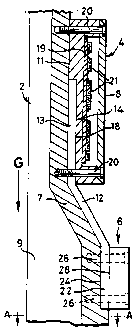Some of the information on this Web page has been provided by external sources. The Government of Canada is not responsible for the accuracy, reliability or currency of the information supplied by external sources. Users wishing to rely upon this information should consult directly with the source of the information. Content provided by external sources is not subject to official languages, privacy and accessibility requirements.
Any discrepancies in the text and image of the Claims and Abstract are due to differing posting times. Text of the Claims and Abstract are posted:
| (12) Patent: | (11) CA 2260305 |
|---|---|
| (54) English Title: | ELECTRONIC APPARATUS |
| (54) French Title: | APPAREILLAGE ELECTRONIQUE |
| Status: | Expired and beyond the Period of Reversal |
| (51) International Patent Classification (IPC): |
|
|---|---|
| (72) Inventors : |
|
| (73) Owners : |
|
| (71) Applicants : |
|
| (74) Agent: | KIRBY EADES GALE BAKER |
| (74) Associate agent: | |
| (45) Issued: | 2002-09-03 |
| (22) Filed Date: | 1999-01-25 |
| (41) Open to Public Inspection: | 2000-07-25 |
| Examination requested: | 1999-01-25 |
| Availability of licence: | N/A |
| Dedicated to the Public: | N/A |
| (25) Language of filing: | English |
| Patent Cooperation Treaty (PCT): | No |
|---|
| (30) Application Priority Data: | None |
|---|
Electronic apparatus is contained in a heat dissipative external enclosure. The enclosure contains at least one unit contained in a thermally conductive internal housing providing RF isolation and mounted on a wall of the enclosure in thermal contact therewith. A wall of the unit has a first recess receiving the evaporator of a heat pipe. The heat pipe is clamped between the external enclosure and the internal housing. The condenser of the heat pipe is lower than the evaporator and is received by a recess in the wall. The evaporator is clamped in the recess by a clamp member e.g. another unit. Because the heat pipe is clamped at its ends, it does not need to be an interference fit in either recess and may thus easily be removed. The inner housing can maintain RF isolation.
Un appareillage électronique est contenu dans une enceinte externe dissipant de la chaleur. L'enceinte contient au moins une unité contenue dans un logement interne conducteur de chaleur, assurant une isolation aux RF et fixé sur une paroi de l'enceinte en contact thermique avec celle-ci. Une paroi de l'unité comporte un premier renfoncement accueillant l'évaporateur d'un caloduc. Le caloduc est serré entre l'enceinte externe et le logement interne. Le condensateur du caloduc est plus bas que l'évaporateur et est logé dans un renfoncement dans la paroi. L'évaporateur est serré dans le renfoncement par un élément de serrage, par exemple une autre unité. Le caloduc étant serré par ses extrémités, il n'a pas besoin d'être ajusté de manière serrée dans un renfoncement et peut ainsi être facilement retiré. Le logement interne peut assurer une isolation aux RF.
Note: Claims are shown in the official language in which they were submitted.
Note: Descriptions are shown in the official language in which they were submitted.

2024-08-01:As part of the Next Generation Patents (NGP) transition, the Canadian Patents Database (CPD) now contains a more detailed Event History, which replicates the Event Log of our new back-office solution.
Please note that "Inactive:" events refers to events no longer in use in our new back-office solution.
For a clearer understanding of the status of the application/patent presented on this page, the site Disclaimer , as well as the definitions for Patent , Event History , Maintenance Fee and Payment History should be consulted.
| Description | Date |
|---|---|
| Time Limit for Reversal Expired | 2016-01-25 |
| Letter Sent | 2015-01-26 |
| Inactive: IPC from MCD | 2006-03-12 |
| Grant by Issuance | 2002-09-03 |
| Inactive: Cover page published | 2002-09-02 |
| Amendment After Allowance Requirements Determined Compliant | 2002-07-02 |
| Letter Sent | 2002-07-02 |
| Inactive: Final fee received | 2002-05-28 |
| Pre-grant | 2002-05-28 |
| Inactive: Amendment after Allowance Fee Processed | 2002-05-28 |
| Amendment After Allowance (AAA) Received | 2002-05-28 |
| Notice of Allowance is Issued | 2002-03-08 |
| Notice of Allowance is Issued | 2002-03-08 |
| Letter Sent | 2002-03-08 |
| Inactive: Approved for allowance (AFA) | 2002-02-27 |
| Application Published (Open to Public Inspection) | 2000-07-25 |
| Inactive: Cover page published | 2000-07-24 |
| Letter Sent | 1999-06-07 |
| Inactive: Single transfer | 1999-05-13 |
| Inactive: First IPC assigned | 1999-03-16 |
| Classification Modified | 1999-03-16 |
| Inactive: IPC assigned | 1999-03-16 |
| Inactive: Courtesy letter - Evidence | 1999-03-09 |
| Inactive: Filing certificate - RFE (English) | 1999-03-03 |
| Application Received - Regular National | 1999-03-01 |
| Request for Examination Requirements Determined Compliant | 1999-01-25 |
| All Requirements for Examination Determined Compliant | 1999-01-25 |
There is no abandonment history.
The last payment was received on 2001-12-28
Note : If the full payment has not been received on or before the date indicated, a further fee may be required which may be one of the following
Patent fees are adjusted on the 1st of January every year. The amounts above are the current amounts if received by December 31 of the current year.
Please refer to the CIPO
Patent Fees
web page to see all current fee amounts.
Note: Records showing the ownership history in alphabetical order.
| Current Owners on Record |
|---|
| LUCENT TECHNOLOGIES INC. |
| Past Owners on Record |
|---|
| WILLIAM GEORGE GATES |